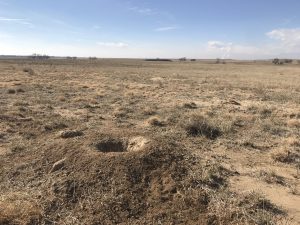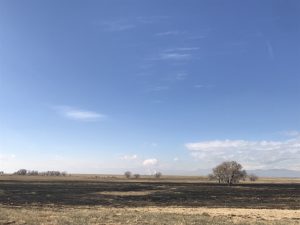ROCKY MOUNTAIN ARSENAL – Prairie used to cover hundreds of millions of acres of North America, from Canada to Mexico and from the Rocky Mountains to eastern Missouri. Much of it has since been plowed over.
“There’s not very much of it anymore,” Rocky Mountain Arsenal (RMA) National Wildlife Refuge manager David Lucas said in a recent interview with Colorado College students. “There’s very little.”
Native grasses have deep root systems that hold down soil and prevent erosion and dust storms, according to the US Forest Service. They also support large biodiversity, mitigate droughts and floods, and renew soil fertility.
But more than 99 percent of tallgrass prairie has been destroyed, according to the Grassland Heritage Organization. In the Rocky Mountain region, only 40 percent of shortgrass prairie remains in relatively unfragmented parcels, Colorado Department of Transportation analysis found.

A former military lookout station for testing mortar aim on the Rocky Mountain Arsenal in Denver, Colorado. Photo Heather Rolph
So U.S. Fish and Wildlife Service employees at the 16,000-acre RMA, located slightly west of the airport in Denver, are trying to bring a small part of that prairie back.
“I always believe natural systems will do better than we can,” said Lucas. Restoring predator-prey relationships and other natural processes is the key to reviving struggling ecosystems, he said.
Beginning in 1943, the government produced mustard gas, nerve gas, and other chemical weapons at the RMA. Later, chemical companies such as Shell produced pesticides on the site. After the RMA closed in 1985, environmental testing established that the site was extremely polluted and unfit for human habitation. It was listed as a hazardous waste site applicable for cleanup under the Environmental Protection Agency’s Superfund act, but nothing was done until then-endangered bald eagles were found roosting on the site – one of the species most affected by DDT, which had been produced at the RMA only scant years before.
Following a $2.1 billion cleanup of the contaminated areas, refuge officials say they are doing their best to revive native ecosystems.
So far, they’re seeing promising results. Nearly the entire acreage has been reseeded with native grasses, and 230 wildlife species live at the refuge, including a prairie dog colony, 180 member bison herd, and one third of the world’s critically endangered black-footed ferret population, Lucas said.
Animals on the RMA even seem to have greater physical fitness than their counterparts at other refuges.
“Our calves are the LeBron James of the bison industry,” Lucas said.
But refuge officials still face daily challenges. The refuge is a preserve for plant and animal holdouts of what settlers once called “the Inland Sea,” but the Denver skyline looms on the horizon. Airplane flyovers are common.
With an influx of population in the Denver metro area and increasing visitation, Lucas said, there are statistically more people creating disturbances.
“There’s a high preponderance of naked people,” he said.
Some of the incidents appear harmlessly bizarre. Refuge officials once found a man on the RMA wearing nothing but a speedo and swim fins, playing violin to a bison, Lucas said. But others can be more serious. Homelessness, gangs, drugs, and alcohol all present problems, and refuge officials have to police the place carefully.

A prairie dog burrow on the Rocky Mountain Arsenal National Wildlife Refuge. Photo Heather Rolph
And while natural systems may endure better than human-created ones, ecosystems on the refuge are strained. Refuge officials are trying to control the spread of the invasive weed cheatgrass by spraying $60,000 worth of pesticides annually.
“There are so many ironies out here,” Lucas said. “We spent billions of dollars to clean up one chemical and now we’re spraying another.”
Cheatgrass, he continued, is “probably the biggest issue facing habitats in the West.”
The RMA is also a crucial area for the reintroduction of black-footed ferrets, a critically endangered species which feeds almost exclusively on prairie dogs. In 1986, the black-footed ferret population dropped to only 18 individuals in captivity.
Sylvatic plague, caused by the same bacterium responsible for the “Black Death” that once wiped out half Europe’s population, lives on in prairie dog colonies. They have no known immunity to the disease, and epidemics can decimate their populations – as well as the critically endangered black-footed ferrets that live in their burrows. Refuge officials spend $175,000 annually on plague management.
“It’s kind of hedging your bets in this business,” Lucas said. “In terms of disease management, what the hell are you going to do?”
In core areas, prairie dogs receive vaccines in the form of peanut-butter coated pills that turn their scat bright blue. In other areas, the prairie dogs are on their own.
“We don’t have a lot of money,” Lucas said.

A bison herd grazes near the area of a prescribed burn, with the Denver skyline on the horizon. Photo Heather Rolph
Fish and Wildlife crew at the refuge must balance their mission of protecting species with educating people on conservation, Lucas said.
“This is a window into the larger organization of the United States Fish and Wildlife Service,” he said. “If all the work is out where people don’t see us, it’s hard to get that connection.”
Fish and Wildlife manages 800 million acres of land nationwide. But this refuge is one of a few large urban wildlife preserves. Money that might formerly have gone towards research efforts is being put towards community outreach and youth programs, targeting the next generation in low-income neighborhoods of north metro Denver.
“Those people are the ones that are going to be voters in the future,” Lucas said. “Maybe then, when somebody wants to punch a hole in some new wilderness, they’ll go ‘I don’t like that.’”

